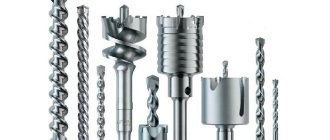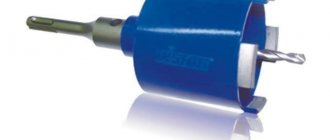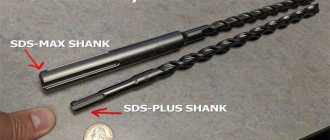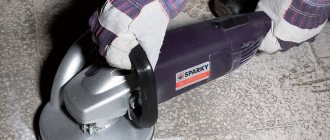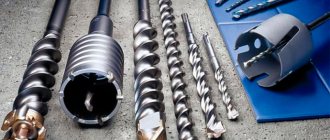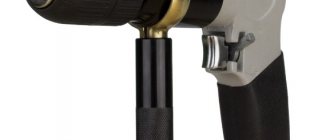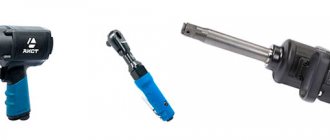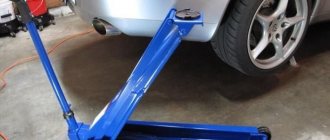Diamond drills are cutting tools for hand tools or stationary drilling machines. They are hollow cylinders with diamonds applied to the cutting surfaces, so they have another name - diamond crowns.
A wide range of diameters (12-600mm) and possible cutting depths (up to 4 m) allow them to be used in many areas: from laying communications during construction or making holes in solid materials, to drilling pits and tunnels in the mining industry. If necessary, the crowns are extended to the required distance using special pipes of any size.
Diamond drilling is the most effective modern method used to work with stone, brick, concrete, porcelain stoneware and other high-strength materials. Advantages of using diamond bits:
- the ability to carry out work with high productivity and speed;
- holes obtained using diamond tools have an absolutely smooth inner surface and ideal dimensions, which eliminates additional processing;
- drilling work can be performed in tight spaces or hard-to-reach places, close to the surface of walls, ceilings or floors or at an angle to the material being processed;
- low vibration level, no dust;
- During construction work, the load-bearing structures of the building do not receive damage, and chips and cracks do not form.
Economically, diamond drills are more profitable than hard-alloy drills both in terms of productivity and efficiency of work, as well as in the speed of their implementation and the possibility of repairing equipment - diamond segments can be repaired. Such tools differ in the way drive mechanisms operate, methods of use, cylinder length, method of connection to the drive, type of segments and other characteristics.
Design of diamond bits
Matrix
The main part that comes into contact with the material being processed and performs the task of abrading it (not cutting it). Two types of diamonds are fixed on the toothed profile: volumetric and cutting. The main function of removing surface layers is performed by bulk crystals, the characteristics and fixing composition of which are selected depending on the hardness of the working material. Scoring diamonds are distributed on the outer and inner parts of the segments and perform the task of protecting the equipment from wear.
The main part that comes into contact with the material being processed and performs the task of abrading it (not cutting it). Two types of diamonds are fixed on the toothed profile: volumetric and cutting. The main function of removing surface layers is performed by bulk crystals, the characteristics and fixing composition of which are selected depending on the hardness of the working material. Scoring diamonds are distributed on the outer and inner parts of the segments and perform the task of protecting the equipment from wear.
Frame
The crown body is made of high-strength steel (fiberglass bodies are also offered, but they can be used with a limited list of materials), and must be tested for impact and balancing.
Shank
The choice of shank type depends on the type of material being processed and the tool used. Shanks designed for various equipment have certain features.
The SDS-plus shank type is suitable for use in household hand-held power tools. With their help, holes and channels are drilled for plumbing systems, the Internet, laying various pipes in the walls of buildings, places for electrical outlets, etc.
For large-diameter holes drilled with high-power equipment, shanks marked with the designation SDS-max are intended.
For processing porcelain stoneware, tiles, and other durable but fragile materials, impactless BSP shanks are used, which allow you to create smooth holes of various depths and diameters.
Standard diameters of crowns for concrete
Holes and recesses in concrete, both for domestic and industrial purposes, may be needed not only for installing sockets, but also when laying pipes, cables, etc. Consequently, the sampling parameters will not be the same, which means that tools with various dimensional indicators: with a certain diameter for socket boxes, for pipes - depending on the cross-section, for cables - in accordance with the dimensions of the route.
Each product is accompanied by instructions, which necessarily indicate the characteristics of the crown, or this information is indicated on the marking.
Crown heads have a wide range of diameters and lengths
Helpful advice! If the diameter of the socket boxes is unknown, you should take measurements with a caliper along the outer edge of the product and purchase a crown in accordance with the obtained indicator.
Concrete drill bits for hammer drills can be sold separately or as a set. Purchasing a kit is advisable if the use is not occasional. Kits, as a rule, contain 5-10 crowns of various diameters, which will allow you to make a hole of any standard size if necessary. Rigid packaging and compact placement of tools in it do not cause problems during storage and help protect products from damage associated with external environmental influences.
Types and cost of crowns for 68 mm concrete
The sizes of boxes for installing sockets and switches are standard. The recesses for them are made using 68 mm concrete crowns. This is the most common option.
For carbide (pobedite) options, the cutters are set at a negative angle of 7°. This arrangement dampens the intensity of the dynamic load on the nozzle and reduces the impact of radial and axial runout. This attachment can be used for rotary hammers with a power of 850 W or more. The SDS Plus system is used as fastening.
68 mm concrete crowns are considered the most common option
A diamond crown with a diameter of 68 mm most often has 4 coated segments. These fragments are made by mixing diamond chips and metal powder. The composition is pressed, resulting in the formation of elements of the desired shape and size, which are then baked. The power of the hammer drill to use this type of attachment must be at least 600 W, the recommended speed is 1000-3500 rpm, the type of attachment is SDS Plus.
The most commonly used bits coated with tungsten carbide have a medium grain and are recommended for working on brick, facing and tiles, foam concrete, and hard gypsum. The optimal speed when working with such attachments is 1500 rpm.
The average price of a diamond drill bit for 68 mm concrete is 7-10 thousand rubles. For pobedite species (coated with tungsten carbide) it is significantly lower - 4-6 thousand rubles. The cost of metal products is 450-600 rubles.
The hammer drill must have a power of at least 600 W to use bits with a diameter of 68 mm
Scope and methods of application of diamond bits for concrete 72 mm
A diamond bit with a diameter of 72 mm is also a fairly commonly used attachment. It is used when making recesses for socket boxes, distribution boxes, or when laying communication pipes. Used with a drill or hammer drill. Crowns of this diameter are divided into two types:
- for dry drilling;
- for wet drilling.
Nozzles recommended for dry work have oppositely placed cutouts on the sides of the cylinder, which ensure cooling of the cutting edge during operation. Options without holes in the cylindrical body require the use of running water for cooling.
Diamond bits for concrete 72 mm are used when working in non-impact mode. With their help you can drill concrete, reinforced concrete, natural and artificial stone, and ceramics. The recommended power of the rotating device is 700 W or higher, rotation speed is 1500-2000 rpm. The cutting fragments of the cutters are laser welded, which further enhances the strength of the attachment.
Using bits with a diameter of 72 mm you can drill concrete, natural and artificial stone, ceramics
Helpful advice! If during operation the rotation speed of the power tool slows down significantly, you should not increase the pressure on the bit. This will not improve efficiency, but will cause wear on the cutting edge.
Features of using crowns for 100 mm concrete
During construction or renovation work, it is often necessary to drill large holes, especially for connecting water supply and sewerage. In such cases, a crown with a diameter of 100 mm is used. You can purchase such a cutter made of hard metal. It is inexpensive - 400-450 rubles. You should not be afraid when purchasing such a cutter made in China; its performance is not inferior to its Russian counterparts.
Related article:
Attachments for an angle grinder: a variety of tools for angle grinders
Nozzles for an angle grinder. Their characteristics. Classification by material and purpose. Cutting, roughing and grinding devices. Wall chaser attachment. Grinder on a chainsaw..
Such a crown for concrete should be given time to cool, and the impact function of power tools should be used. A distinctive quality of this type of cutter is its fairly rapid wear. If it gets on the reinforcement, the cutting edge is significantly damaged, so its further use is called into question. Before starting work, you need to be sure that there are no metal elements along the drilling path.
To drill large holes, use a crown with a diameter of 100 mm
Diamond bits for drilling concrete are more durable in operation when making holes, especially for drilling large holes. If the amount of work to be done is significant, it is worth purchasing the latter option. Even at a significantly higher price (compared to metal crowns), such a cutter may turn out to be more cost-effective.
Concrete crown 110 mm: application and specifics of fastening
The diameter of metal bits does not exceed 100 mm, so to drill holes 110 mm or larger you need to purchase a diamond-coated cutter.
To work with a nozzle of this size, you will need an electric drill or hammer drill with a power of at least 100 W.
When working on concrete with a 110 mm bit, it is better to use water cooling. It will prevent overheating and falling off of the soldered edge.
Crowns with a diameter of 110 mm are attached using two types of adapters
Some difficulties may arise in the process of attaching the attachment to the power tool. The main part of the bits is compatible with rotary hammers and drills. As for options with large diameters (150 mm or more), some models require a special size of connecting elements. There are two types of cartridges, which play a major role in the mounting method:
- SDS-plus. They are part of the design of low-power tools whose weight does not exceed 5 kg.
- SDS-max. They are equipped with heavier and more powerful models of rotary hammers.
The attachment must have the appropriate shank to match the type of attachment.
The industry produces adapters that allow you to install a crown of one type on a chuck for another purpose.
To work with a 110 mm nozzle, you will need a hammer drill with a power of at least 100 W
Important! You cannot purchase and install a 110 mm concrete bit for a hammer drill with a power of 800 W or less. Using an adapter makes it possible to connect the structure, but this does not affect the operation of the engine. A large crown on a low-power power tool contributes to inevitable overheating with the ensuing consequences.
Drilling type
Like other diamond cutting tools, drills can be used for dry or wet drilling.
The wet method of work involves cooling the tool with water or a special liquid that prevents the drill from overheating and removes small fractions of the surface being processed. In addition, when performing work, especially with highly reinforced materials, the diamond segments heat up and fall out, which leads to rapid wear of the equipment. Wet drilling is also more productive and reduces work time, so it is preferable for industrial use.
Dry drilling is preferable when remote from water sources, when working with certain types of materials, when it is impossible to use equipment that provides liquid supply, and when the cut site must remain clean.
The difference between diamond drills intended for different types of drilling lies in the method of soldering the diamond elements: elements for wet drilling are connected by solder, diamonds in crowns used for dry drilling are connected to the base by welding. Another difference is the distance between the segments; in “dry” drills it is larger, which allows the cuttings not to get stuck between the elements of the cutting edge.
Crowns designed for water-cooled operation cannot be used for dry work - they instantly fail.
Differences in cutting edges
The cutting edge can consist either of individual segments or be a circular, continuous coating of diamond elements (such products are intended for working with tiles, tiles, ceramics, and other fragile materials). The number of segments on the head depends on its diameter: 65 mm products have 32 diamond segments, and 4.5 mm crowns have 5.
The types of segments depend on the material the drill will work with and are attached to the base either by laser soldering or silver-containing solder. The former can be used for both dry and wet work, the latter are not intended for dry drilling.
Diamond elements can be located either along the edge of the edge or fill it in thickness and release new layers as it wears. A similar technology is used in drills designed to work with durable coatings, porcelain stoneware, natural stone, and glass. The tool used to cut reinforced concrete contains segments arranged in a specific order.
The matrices also differ in hardness, determined by the type of bond, on which the speed of abrasion of the working surface depends. Diamonds are fixed to the work surface in several ways. In the first case, an electrolyte is used in which the working surface is placed. In this way, tools for household needs are made. The second manufacturing method is suitable for crowns working with reinforced concrete and other high-strength materials. Large and small diamonds are mixed with a binder, which contains molybdenum, chromium, cobalt or bronze in the required proportions. The mixture is then pressed under high pressure and combined with the matrix using one of the methods described above.
The composition of the binder will determine the hardness of the drill. Soft bits are used when working with durable materials - rapid abrasion of diamonds prevents clogging of the edge, which makes drilling much worse. Solid matrices are intended for crumbling abrasive materials. In this case, the process is slower, but the crown remains operational longer. Brick, limestone, and foam concrete are processed with this tool. Crowns are also available with a universal bond; the performance of such matrices is average.
Segments with a soft matrix are marked with the letter “M”; for working with reinforced concrete, a binder with medium hardness is used, marked with the letter “C”; hard matrices (marked with the letter “T”) are used for high-quality concrete and are intended for operation at reduced speeds. In addition, there are “KS” crowns, which are classified as “soft” and have special cavities for air cooling.
The next difference that must be taken into account when choosing diamond bits is the shape of the working part, which can be:
- cylindrical - the cut passes only along the edges of the drill, which allows the crown to contact the surface being treated over a small area; this drilling method is best suited for creating holes with a large diameter;
- conical – similar in appearance to ordinary steel drills, intended for working with stone at shallow depths;
- feather - used for deep drilling of natural stone to a great depth and are made in the form of a wedge-shaped plate soldered into the base of the crown.
Varieties
Diamond crowns for concrete are in most cases divided into two large categories - standard and KS series. The first ones are the most popular. They are intended for surfaces of initial and medium strength, and therefore are cheaper than analogues.
On the other hand, KS crowns are necessary when working with durable concrete, or reinforced with reinforcement or marble chips. The matrix holds polycrystalline diamonds within the contour of the edge. It is this design feature that allows such crowns to replace their carbide counterparts. This entails additional working conditions.
Read here: What types of aluminum rivets are there - installation, characteristics and tips on how to choose a rivet
We are talking about a method of operation that should only be shockless, which definitely has a positive effect on the surface with which there is contact - the holes are neat and without unnecessary damage.
Dimensions
The choice of crown diameter depends on the thickness of the hole to be obtained. So, for a 65 mm hole, which is usually used for installing socket boxes, you need to select a drill with a thickness of 2-3 mm more - this difference is required to fill it with a solution that will hold the product in the wall. The same applies to other jobs.
In this case, you should take into account the power and type of drilling machine, its compatibility with the crown. Crowns with a diameter of 25 mm are excellent for devices whose power is no more than 1 kW. At the same time, more powerful machines use larger diameter drills. The outer diameter of the crowns is divided into small - up to 1.2 cm inclusive, medium - 3.5-8.2 cm, large - 15-40 cm and especially large - 40-120 cm. It is necessary to ensure that the standard for fastening the crowns, which differ in threaded, SDS and BSP, matches the standard.
Lifetime of diamond bits for concrete for socket boxes
The resource of the crown depends on objective and subjective indicators. The first should include the characteristics declared by the manufacturer. They depend on the characteristics of the cutting segments and the quality of the material intended for processing. For example, a concrete bit with a diameter of 200 mm, which has a saturated diamond coating, is designed for 18-20 linear meters of drilling in reinforced concrete.
The 68 mm SDS Plus diamond bit for concrete can cover 14 linear meters under optimal conditions. The larger the diameter of the crown, the more significantly its resource increases. It is ensured by the presence of a large number of diamond-coated cutting segments.
The nominal life will be confirmed only under conditions of proper use of the crown.
Subjective reasons affecting the resource of the nozzle include the conditions and method of operation:
- The use of shock operating mode of power tools for diamond-coated crowns significantly reduces the service life.
- Non-rigid fastening of the support post leads to skew of the crown and provokes beating, which has a detrimental effect on the condition of the cutting elements.
- Excessive pressure and uneven feeding can result in rapid damage to the spray layer.
- Drilling without water contributes to overheating and falling off of the cutting layer of the crown.
- As a result of using attachments that are not intended for drilling concrete with reinforcement, the metal can not only destroy the coating of the cutting segments, but also lead to damage to the integrity of the crown.
Important! It is possible to renew the diamond coating on the cutting elements of the nozzle, but it is impossible to restore the shape of the cylinder - such a crown cannot be repaired.
From all of the above, we can conclude that the nominal resource determined by the manufacturer will only be confirmed under conditions of proper use of the tool.
The use of impact mode for diamond-coated bits significantly reduces the service life
Diamond bit manufacturers
Diamond tools for drilling are offered on the domestic market, both from foreign manufacturers that have long gained popularity, and from Russian companies that work closely with end consumers and are able to produce tools of world-class quality.
An approximate range of diamond bits from various manufacturers can be seen in the table:
If you choose the right diamond bit, it will provide high performance and long service life. In this case, one should, first of all, take into account the material for which the drill is intended to work, the capabilities of the tool used and the possibility of repeated restoration of the working surface - due to the fact that worn-out segments can be restored, significant savings are achieved.
Metal crown: tips for proper use
The centering drill must be included with the crowns
- You need to make the right choice; to do this, you should carefully read the labeling information. The packaging must indicate the dimensions, country of origin (which to a certain extent indicates the quality of the product), material of manufacture, features of accessories and devices. If the marking does not provide complete information about the annular cutter, there is reason to doubt the quality of the tool.
- During use, do not neglect the manufacturers' recommendations. Using the crown for purposes other than intended will result in damage to the instrument.
- If the kit does not include a centering drill, it must be purchased taking into account certain requirements. For example, the drill bit of a drill attachment must be cross-sharpened, otherwise instantaneous and accurate centering will not be possible.
- The need to regulate the number of revolutions was discussed more than once in the article. It should be emphasized that this condition is perhaps the most important for increasing the service life of metal crowns.
With the correct selection and use of crowns, a hole in metal can be made in a matter of seconds. The tool is applicable for various household and industrial purposes. Compliance with technical requirements can extend the service life for a long time. Conversely, one thoughtless use can cause defects that will make the crown unsuitable for use.
